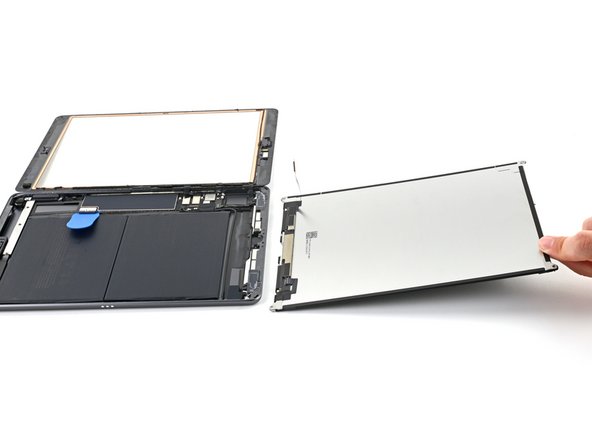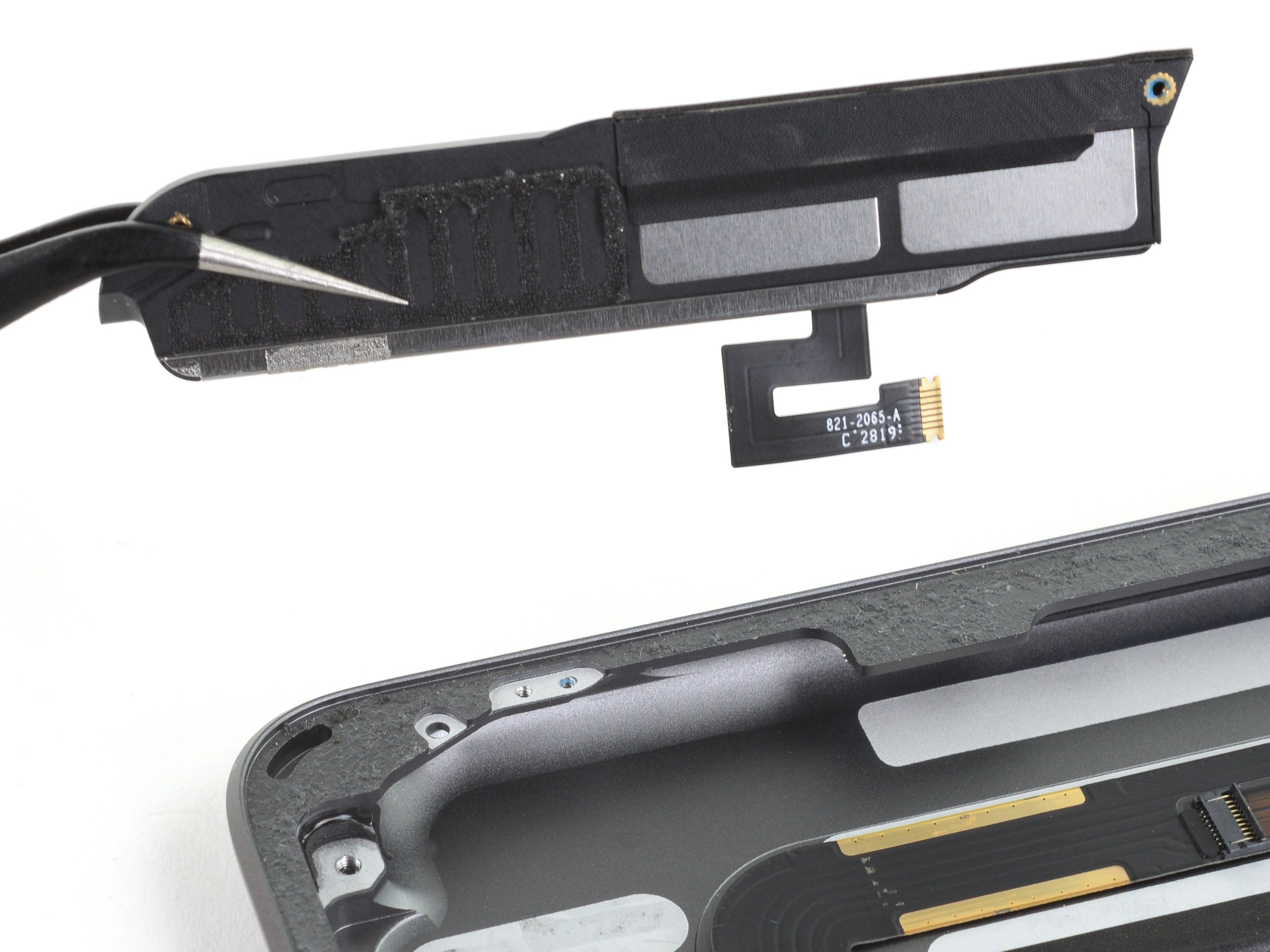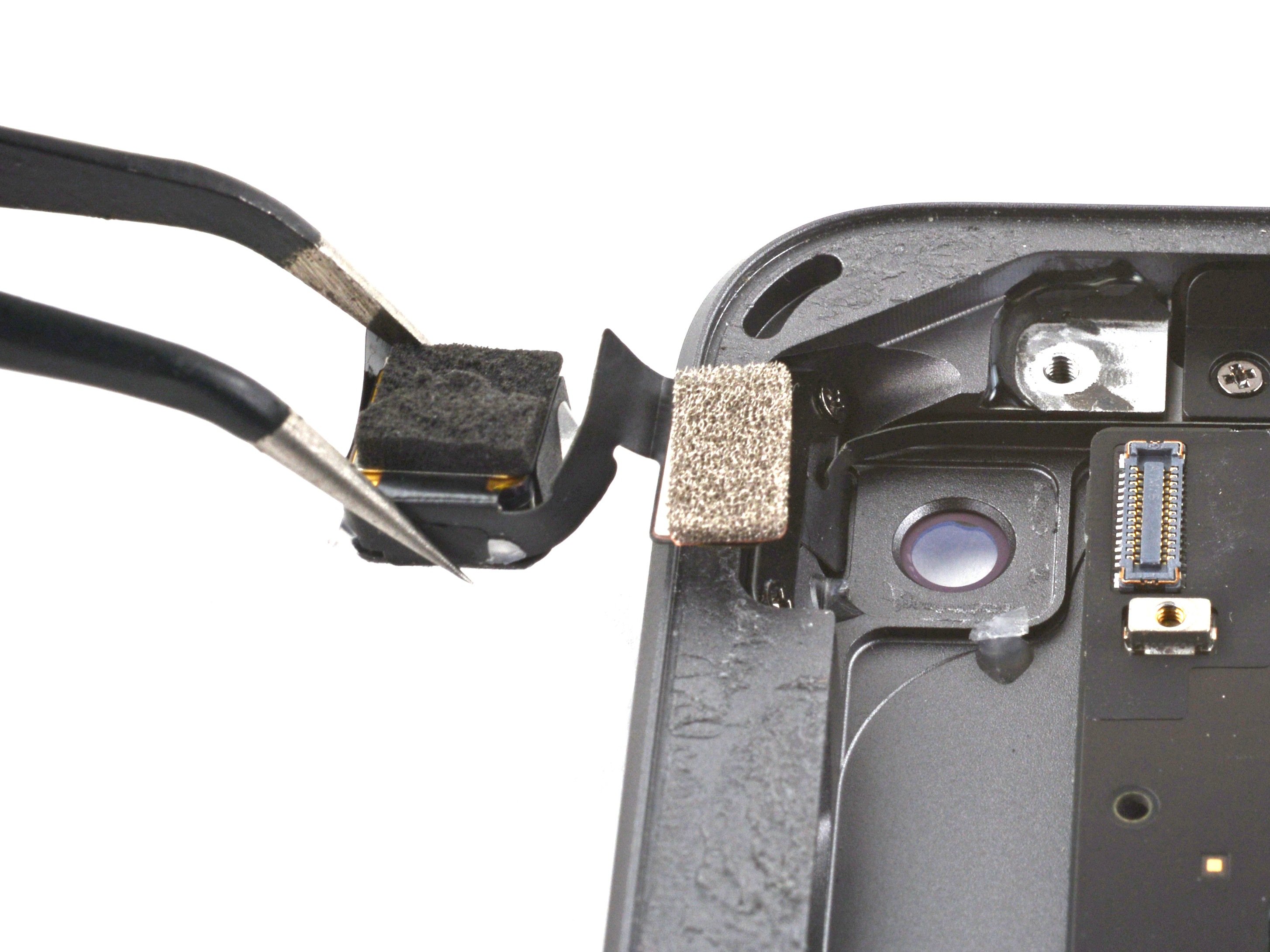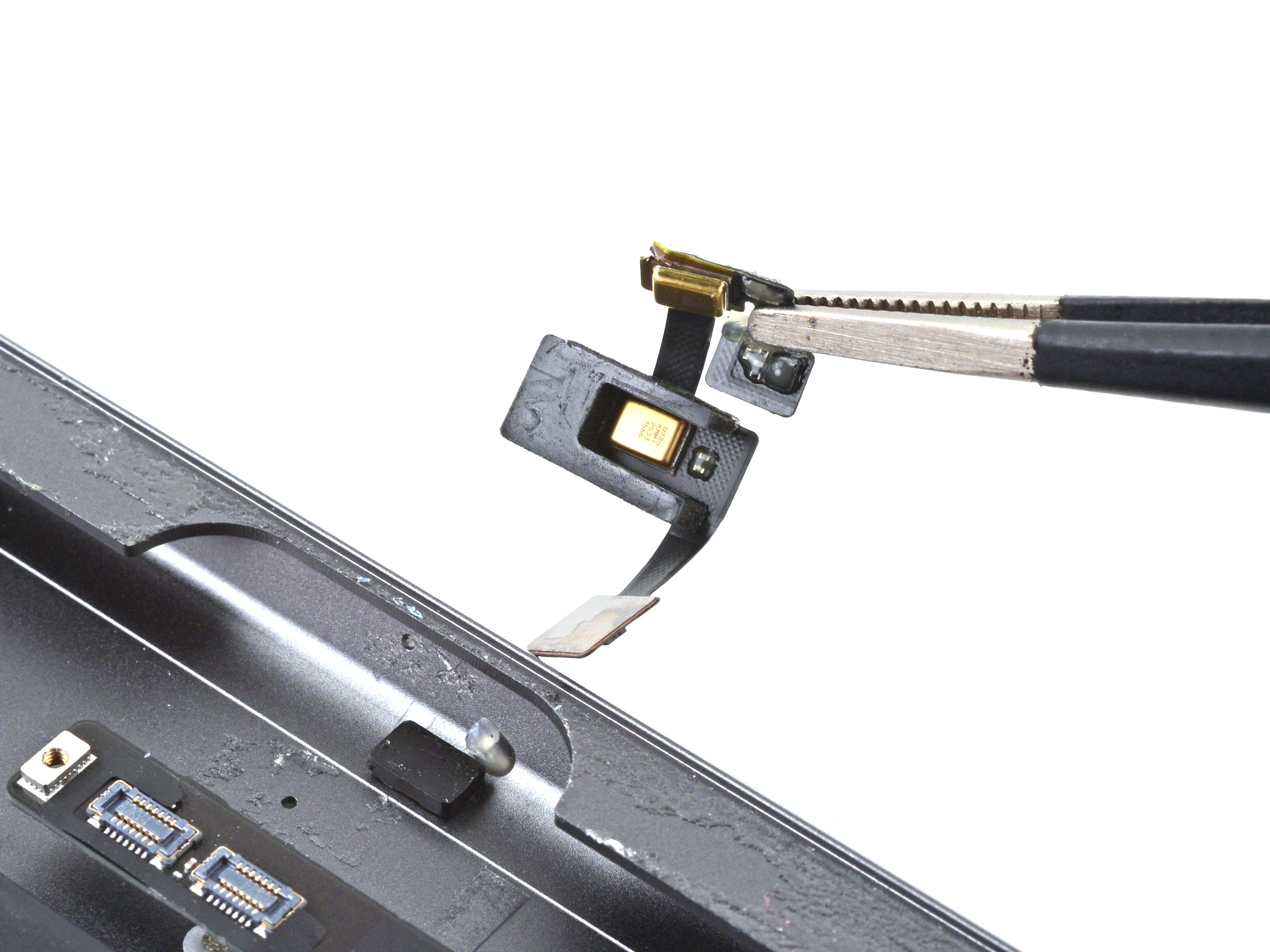iPad 8 Left Bluetooth and Wi-Fi Antenna Replacement
Duration: 45 minutes
Steps: 49 Steps
For your safety, make sure to drain that battery below 25% before diving into your iPad disassembly adventure!
Dive into this guide to swap out the left Bluetooth and Wi-Fi antenna in your iPad 8 Wi-Fi! Just a heads up: this guide is specifically for the Wi-Fi version. If you’re rocking the LTE version, check out the alternative guide. For safety's sake, make sure to drain your battery below 25% before you start disassembling your iPad. This little step helps minimize the risk of a fiery situation if the battery gets accidentally harmed during the repair. If your battery is looking a bit puffed up, take the necessary precautions. When it comes to isolating the battery with a battery blocker, tread carefully! The battery contacts are delicate and can easily get damaged, leading to unwanted problems. If you decide to tackle the guide without isolating the battery, stick to non-metal tools wherever possible (except for those pesky screws) to prevent any battery shorts and protect those sensitive circuit components. Don't forget, you’ll need some replacement adhesive to wrap up this repair. Some images in this guide might come from a different model, so they may not match up perfectly, but no worries—they won’t mess with the repair steps!
Step 1
- Warm up your iOpener and give it a cozy two-minute hug on the left edge of your device.
Tools Used
Step 2
- While the adhesive is softening up, keep a sharp eye out for these parts that really don’t like being poked around:
- Front camera
- Antennas
- Display cables
Step 3
In the next three steps, we'll introduce you to the Anti-Clamp—our nifty tool designed to help you breeze through the opening process. Not using the Anti-Clamp? No problem! Just skip ahead three steps for a different approach.
Want to master the Anti-Clamp? Check out our handy guide for all the details.
If your iPad's surface is feeling a bit too slick for the Anti-Clamp to grip, a little tape can work wonders to create a better hold.
- Slide the blue handle back to release the Anti-Clamp's arms.
- Prop up your iPad with something so it sits level between the suction cups.
- Set the suction cups close to the center of the left edge—one near the top, the other near the bottom.
- Keep the bottom of the Anti-Clamp steady while pressing down firmly on the top cup to create suction.
Step 4
- Give the blue handle a gentle tug forward to secure those arms in place.
- Twist the handle a full 360 degrees or until you see those cups start to stretch—you're almost there!
- Keep an eye on those suction cups; they should be in perfect harmony. If they start to drift apart, just loosen them a tad and nudge those arms back into alignment.
Step 5
Turn no more than half a twist at a time, then take a breather for a minute. Let the Anti-Clamp and a little patience do their magic!
Want the full scoop on using a hair dryer like a pro? Check out this guide.
If the Anti-Clamp isn’t opening up enough space, just warm the spot a bit more and twist the handle clockwise half a turn to get things moving.
- Give it a minute to let the adhesive loosen up and create a little gap.
- If the screen isn’t warming up enough, try using a hair dryer along the left edge of the iPad to heat things up.
- Once the Anti-Clamp has opened a good-sized gap, slide an opening pick under the digitizer.
- Skip the next step.
Step 6
If your screen is sporting some serious cracks, a clever trick is to cover it with a layer of clear packing tape to help that suction cup stick like it’s meant to. If you’re feeling adventurous, you could even go for some super strong tape instead of the suction cup. And if you’re in a real pickle, a little superglue can do wonders to attach that suction cup to the broken display. Remember, if you need help, you can always schedule a repair.
- Once the screen feels nice and toasty, grab a suction handle and pop it onto the left edge of the screen, as close to the edge as you can get.
- Give the screen a gentle lift with the suction handle to open up a tiny gap between the digitizer and the frame.
- Slide in an opening pick right into that gap you just created between the digitizer and the frame.
Tools Used
Step 7
No stress if you spot the opening pick poking through the digitizer — just gently pull it out. The LCD should stay safe, but watch out for any sticky adhesive that might be tricky to clean later.
- Pop in a second opening pick right where you made that gap. You're doing great!
- Slide that pick down toward the bottom-left corner of your device to break free from that sticky adhesive. You're almost there!
- Keep the pick snug in the bottom-left corner to stop that adhesive from sealing up again. You've got this!
Step 8
- If your opening pick decides to get a little clingy with the adhesive, just roll it gently along the edge of the iPad to keep that adhesive separation party going.
Step 9
- Gently slide your trusty opening pick towards the top-left corner of your device to break that adhesive seal. You've got this!
- Once you've made some progress, leave the pick right where it is in the top-left corner to keep that adhesive from getting cozy again.
Step 10
- Warm up that iOpener and place it on the top edge of your device for two minutes. Let the magic happen!
Tools Used
Step 11
- Gently swivel the pick around the top-left corner to loosen that stubborn adhesive and keep things moving!
Step 12
Keep the pick away from the front camera lens to avoid any unwanted scratches or damage. The next steps will guide you on how to steer clear of it with ease.
- Gently glide the opening pick along the top edge of your device, but hold up just short of the front camera to keep things safe and sound!
Step 13
- Gently pull the pick out so only its tip stays between the digitizer and frame — nice and easy!
- Slide the pick over the front camera area to carefully loosen the adhesive holding things together.
- Keep the pick resting just to the right side of the front camera before moving on to the next step.
Step 14
- Pop that pick back in and shimmy it up to the top-right corner of your device to fully break free from that pesky adhesive.
- Keep the pick snug in the top-right corner to stop that adhesive from getting all clingy again.
Step 15
- Warm up an iOpener and give it a cozy 2-minute rest on the right edge of your device.
Tools Used
Step 16
- Gently twist the pick around the top-right corner to loosen that stubborn adhesive like a pro.
Step 17
The display cables hang out about halfway up from the bottom edge of your iPad. Slide carefully and stop once you’re about three inches from the bottom—easy does it!
- Grab a new opening pick and gently slide it along the right edge of the iPad until you hit the middle. Keep it steady and easy—no need to rush here!
Step 18
- Warm up an iOpener and stick it to the bottom edge of your device for a solid two minutes to loosen things up.
Tools Used
Step 19
Avoid spinning the pick all the way around the corner to keep the antenna safe and sound.
- Gently slide the pick into the bottom-left corner to break that adhesive seal like a pro.
- Once you've got it in there, leave the pick in the corner and get ready for the next step.
Step 20
Slide the pick towards the home button, not away from it – you definitely don’t want to mess with the antenna!
If the pick needs another pass over this section, simply remove it and re-insert it starting from the bottom-left corner.
- Pop in a fresh opening pick right into that gap you just made at the bottom edge of your iPad.
- Gently glide the pick over the antenna, but stop just shy of the home button.
- Keep the pick to the left of the home button before you move on.
Step 21
Be gentle with that pick! Only slide it in up to 1mm to keep your antenna safe and sound. No need to go too deep here!
- Time to bring in the opening pick! Slide it gently into the gap you've just made.
- Now, carefully slide that pick under the home button and aim for the bottom-right corner. Just make sure the tip of the pick stays between the digitizer and the frame. You're almost there!
Step 22
Keep the pick moving gently towards the home button, not away from it, or you might accidentally mess with the antenna. Stay steady!
If you find yourself needing to slide that pick over this section once more, just pop it out and reinsert it at the bottom-right corner. You've got this!
- Slide the pick towards the home button, making sure to break the bottom adhesive free.
- Now, leave the pick just to the right of the home button and get ready to move on.
Step 23
- Warm up an iOpener and place it on the right edge of your device for a cozy two minutes.
Tools Used
Step 24
Take it easy and show some love for this step! Make sure the adhesive is nice and toasty, and gently work your pick to separate all that sticky goodness. Remember, it's totally okay to hit pause and reheat if you need to!
If you feel some stubborn resistance, just warm up the edges again and gently slide your opening pick along them to loosen things up.
- Gently twist the two opening picks at the left corners of your iPad. This will lift the digitizer just enough to break the final bits of adhesive loose. Take it slow and steady—you’ve got this!
Step 25
- Gently lift the left edge of the digitizer to start peeling away the adhesive along the right side of the iPad. Take it slow and steady—you’ve got this!
Step 26
- While gently holding the digitizer, slide an opening pick between the display cables to gently break free the last bit of adhesive. Take your time, no rush – it’s all about precision here!
Step 27
- Once the adhesive has been fully loosened, gently open the digitizer like a book and lay it flat, parallel to your device.
- As you put everything back together, give the frame and digitizer a good cleaning with some isopropyl alcohol to get rid of any leftover adhesive. If you're reusing the digitizer, make sure to replace the old adhesive with fresh strips or pre-cut adhesive cards.
- Be extra careful with those display cables during reassembly. Make sure they're neatly tucked under the LCD screen to avoid any damage when you close it all up.
Step 28
- Grab your trusty Phillips screwdriver and let's get those four 4.3 mm-long screws out of the way to free the LCD from the frame. You've got this!
- As you tackle this repair, keep an eye on those screws! Treat them like precious gems and remember where they belong to keep your device safe and sound.
- If there's any tape hiding those LCD screws, gently peel it away so we can see what we're working with.
Step 29
Hold off on pulling the LCD all the way out just yet—it’s still hanging on by that sneaky little flex cable.
- Gently wedge the flat end of your spudger under the LCD just enough to lift it out of its spot so you can grab it with your fingers.
- Flip the LCD over like turning a page in a book—lift near the camera and rotate it over the home button side of the frame.
- Set the LCD down on a clean, soft, lint-free surface so you can easily access the display cables without any worries.
Tools Used
Step 30
- Grab your trusty Phillips screwdriver and unscrew the 2.3mm-long screw that’s holding the battery connector in place on the logic board. Nice and easy!
Step 31
These images give you a clear view of the battery connector located under the logic board. Use them as your guide while you gently disconnect the battery.
Notice the clever cantilever springs on the logic board that press down on the battery contact pads. Since both the logic board and battery are glued in place, you'll need something slim and flexible to slide between the contact points to safely disconnect the battery.
Step 32
Watch out when you're isolating the battery with a battery blocker! Those battery contacts can be a bit delicate and might bend or break, leading to some serious trouble. Take your time and be gentle!
Make sure the battery blocker is positioned with the logo facing up, just like the perfect placement for a VIP guest at a party.
Don’t force the battery blocker under the connector. If you're struggling, try using a playing card to safely disconnect the battery instead. Think of it like sliding a secret note under the door—gentle and smooth.
The battery blocker or playing card should glide easily under the logic board, no obstacles in sight. Once it's in, it should sit at a comfy 15-degree angle, just like it's relaxing on a hammock.
- Slide the battery blocker under the logic board's battery connector, but give it a little 35-degree tilt. It's like a gentle nudge—nothing too crazy!
- Once it's in place, just let it chill there while you continue with the rest of the steps.
Tools Used
Step 33
- Grab a Phillips screwdriver and take out the three 1.4 mm screws holding down the display cable bracket.
Step 34
- Gently grab your tweezers (or just your fingers, if you're feeling bold!) and lift off the display cable bracket. Easy peasy!
Tools Used
Step 35
- Grab the flat end of a spudger and gently lift the LCD cable connector up and off. No need to rush here, take your time!
- When you're ready to re-attach that press connector, carefully line up one side and give it a gentle press until it clicks into place. Then repeat the process on the other side. Easy does it!
- Remember, avoid pressing on the middle. If the connector's not quite aligned, you could bend the pins, and that’s a whole new level of trouble!
Tools Used
Step 36
- Carefully lift off the LCD and lay it down face-down on a clean, soft, lint-free spot—treat it like the VIP it is!
Step 37
- Grab a pair of tweezers and carefully peel off the tape that’s covering the home button cable ZIF connector. Take it slow and steady!
Tools Used
Step 38
- Grab your trusty spudger, an opening tool, or even your fingernail, and gently lift that little hinged locking flap on the home button cable ZIF connector. You've got this!
Tools Used
Step 39
- Grab your tweezers and gently pull the home button ribbon cable straight out of the ZIF connector—nice and easy does it!
Tools Used
Step 40
To keep your iPad safe and sound, remember to only pry on the connectors themselves and give the socket on the logic board a break!
- Gently wedge the flat end of your trusty spudger under the two digitizer cable press connectors to pop them loose.
Tools Used
Step 41
Be careful not to damage the home button ribbon cable – it's pretty delicate, so treat it like it's made of paper. Handle with care!
- Gently slide the flat end of your spudger under the vibration isolator located at the bottom-right corner to lift it up.
- Take out the vibration isolator carefully.
Tools Used
Step 42
The home button cable is held in place with a bit of gentle adhesive.
- Grab some tweezers and gently lift the home button cable away from the frame. You've got this!
Tools Used
Step 43
Grab your trusty opening pick and gently slice through any stubborn adhesive still clinging the front panel assembly to the frame. It's like giving your device a little spa treatment!
Watch out! Without the right insulation, parts of the digitizer might accidentally touch other components, leading to some frustrating touch input glitches. Let's keep those connections in check!
The insulation is a sneaky little thing—it's not visible to the naked eye and is quite different from the foam dust barrier strips you might find on many iPads. Keep an eye out for it!
- Carefully remove the front panel assembly.
- If your new display starts acting like it’s haunted with 'ghost' or 'phantom' touches, don’t panic! Simply apply a thin layer of insulating tape, like Kapton (polyimide) tape, to the highlighted spots on the back of the panel. Replacement digitizers usually come with the right insulation, so you probably won’t need to add any tape.
- When putting everything back together, make sure to scrape off any leftover adhesive from the iPad. Then, clean those glued areas with high-concentration isopropyl alcohol (90% or higher) and a lint-free cloth. This preps the surface for fresh adhesive and helps it stick like a champ.
- Give your iPad a quick test to make sure everything works, then use pre-cut adhesive strips on the back of the display following the display adhesive guide before sealing it up tight.
Step 44
- Slide the pointed tip of your spudger gently under the left antenna cable and lift it up to disconnect it. Keep it steady, and it'll come off with ease.
- Reconnecting these can be a bit tricky, but no worries! Just hold each connector over its socket and press down with the flat end of your spudger. It should click right into place.
Tools Used
Step 45
Hold onto the antenna cable by the cable itself and steer clear of the connector! Tugging on coaxial cables by their connectors can lead to a break. Let's keep it safe and sound!
The left antenna cable is held down by tape that's actually under the tape for the right antenna cable. If you're struggling a bit, just disconnect the right cable and peel it up. That should give you more room to work!
- Gently lift the left antenna cable off the rear case. Just a little nudge, and it’ll come right up!
Step 46
- Grab that trusty spudger and gently wiggle the flat end under the vibration isolator in the bottom left corner of your iPad. It's like a little dance move, but for your device!
- Once you've got it lifted, use a pair of tweezers to carefully pluck the vibration isolator out. You're doing great!
Step 47
- Grab your trusty Phillips screwdriver and take out the three screws holding down the right antenna.
- One screw is 2.3 mm long,
- and the other two are 1.4 mm long each.
Step 48
The antenna cable is held in place on the speaker by a tiny metal bracket. This bracket is permanently crimped onto the antenna and glued down to the speaker’s casing. To get the antenna out, you’ll need to carefully break through the adhesive.
- Slip an opening pick right between the speaker enclosure and the bracket. You're doing great!
- Gently glide that pick towards the charging port to break the adhesive seal. Keep it up!
- Carefully push the bracket away from the speaker to free it from the tape beneath. Almost there!
Step 49
- Put your device back together by following these steps in reverse order.
- Remember to recycle your electronic waste responsibly at an R2 or e-Stewards certified recycler.
- If things didn’t turn out quite right, try some basic troubleshooting or reach out to our iPad 8 Answers community for a hand.
- And if all else fails, you can always schedule a repair with us!




































































































































